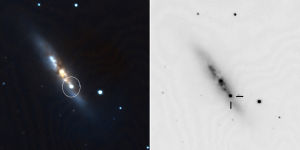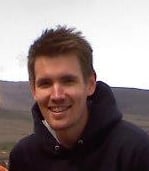
Supernova
At left, a false color image of the supernova in the galaxy M82 made using several imaging filters. Right, another image taken with Lind Hall’s telescope, M82 is the patch of light — made from its tens of billions of stars — running from the upper left of the images toward the lower right. The supernova, dubbed SN 2014J, is marked. All the other stars in the image are foreground stars in our own galaxy and are 10,000 times closer to us than SN 2014J,so they appear as bright as SN 2014J, but are actually billions of times dimmer.
Posted: Wednesday, February 12, 2014 2:00 pm
In the observatory above Lind Hall, Ernest Skousen hunkered down with his coffee, cold-weather gear and the telescope’s computer late in the evening Jan. 31. “We were ready for the all-nighter,” he said.
Astronomy students in England happened along the supernova — a profoundly energetic explosion which can expel more energy in a few months than the sun will through its entire multi-billion year lifespan — catching the object in their scopes Jan. 21.
Berghoff, also a senior, was already doing research work on asteroids when he caught a news item about the supernova, called SN 2014J on Facebook.
“Sure, I maybe should be focusing on asteroids,” he recalled thinking. “But this is too cool.”
The two, who have a few classes together, brought it to Braunstein’s attention.
Even though the weather had been cloudy, they knew SN 2014J might be bright enough to pick up with Lind Hall’s telescope, so they decided to try.
Skousen, who studied meteorology in community college before coming to Central, kept an eye on the weather, thinking Friday, Jan. 31 was their night.
Slightly ahead of plans, the skies were clear Jan. 29. He got out of lab, ate dinner, and went to meet the others, to find that Braunstein had sent the computer they were to use in for repairs to get ready.
Luckily the weather held when Friday came around, Skousen said.
They headed up to the observatory and started the computer.
It froze.
They turned it off and on. It froze again.
They fiddled with the mouse and the keyboard. Still no luck.
The repairs made to the computer involved cloning the entire hard drive to another computer. When the technicians did that, it seemed they used a wireless mouse and keyboard.
Skousen said they ran out to scavenge a standard, plug-in keyboard and mouse, and things started working again.
You know you’re doing good science when everything’s going wrong, he joked.
Science isn’t all just lab work and data crunching, he said.
“Most of the science is problem solving, when you want to do something as cool as that,” he said, such as looking at an exploding star in another galaxy.
They were able to get a bead on the supernova, a faint glitter of light in galaxy M82, another faint, yet slightly larger blob of light.
Data
The Lind Hall observatory telescope can only gather so much helpful data, Braunstein said, but there’s still useful information to find.
Supernovae can help as a yardstick to determining long astronomical distances, he said.
“In astronomy, in some sense, that’s the most fundamental measure you can take,” he said, and it can be a difficult number to find.
A star millions of times brighter than the sun looks like a small point here on Earth since it’s so far away.
“We need these distances to start finding out the other properties of these astronomical objects,” he said.
Getting the distances right helps toward answering other questions, such as an object’s composition and brightness.
“Because this is such a close supernova and so many people are able to collect data on it, it’s going to be able to refine our models of supernovae,” he said.
Skousen gave all the credit to Braunstein for his help tracking the supernova, and helping through last-minute repairs.
“The guy’s smart and resourceful enough to be some company billionaire,” Skousen said. “But he absolutely and throughly enjoys being a teacher.”
The group recorded images of the supernova using different filters, and were able to put those together to create a false-color approximation of the image.
“There is something very primordial about this picture, about this supernova,” Skousen said.
That supernova happened 11 million years ago, and its light only now travelled far enough for us to see it.
Skousen said he can get philosophical about science at times.
“All the heavier elements in our bodies were born in these super nuclear furnaces. … We are made from the very process that we are seeing in that telescope,” he said.
“That’s our creation right there, and so studying that is helping us along those answers of where do we come from, why are we here, where are we going.”
0 Comments on Supernova seen by CWU physics students - Daily Record: Members as of 1/1/1900
Add a Comment



.jpeg)

